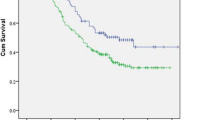Abstract
Objective
Esophageal squamous cell carcinoma (ESCC-R) is a rarely encountered sequela of chest radiation. Treatment is limited by toxicity with reirradiation and complex surgical dissection in a previously radiated field. The clinical presentation, prognosis, and treatment selection of ESCC-R remain undefined.
Methods
A retrospective review of patients with esophageal squamous cell carcinoma at a single institution between 2000 and 2017 was performed to identify patients with previous radiation therapy (≥ 5 years delay). Clinicopathologic characteristics, treatment, and outcomes of ESCC-R (n = 69) patients were compared to patients with primary esophageal squamous cell carcinoma (ESCC) (n = 827). Overall survival (OS) and cumulative incidence of recurrence (CIR) were compared using log-rank and Gray’s tests, respectively.
Results
Median time from radiation to ESCC-R was 18.2 years. The majority of ESCC-R patients were female and presented with earlier disease and decreased behavioral risk factors. ESCC-R treated with surgery alone had worse OS than ESCC (5-year 15 vs 33%; p = 0.045). Patients with ESCC-R who received neoadjuvant treatment had higher risk of postoperative in-house mortality (16.7 vs 4.2%; p = 0.032). Patients with ESCC-R treated with surgery alone and definitive chemoradiation had higher recurrence risk than those with neoadjuvant + surgery (5-year recurrence 55 and 45 vs 15%; p = 0.101).
Conclusion
Neoadjuvant chemotherapy or chemoradiation should be used whenever possible for ESCC-R as it is associated with lower risk of recurrence. The improved survival benefits of aggressive treatment must be weighed against the higher associated postoperative risks.







Similar content being viewed by others
References
Miller KD, Siegel RL, Chieh Lin C, et al. Cancer treatment and survivorship statistics, 2016. CA Cancer J Clin 2016;66:271–289.
Bryant AK, Banegas MP, Martinez ME, Mell LK, Murphy JD. Trends in radiation therapy among cancer survivors in the United States, 2000-2030. Cancer Epidemiol Biomarkers Prev 2017;26:963–970.
Hull MC, Morris CG, Pepine CJ, Mendenhall NP. Valvular dysfunction and carotid, subclavian, and coronary artery disease in survivors of Hodgkin lymphoma treated with radiation therapy. JAMA 2003; 290:2831.
Stubblefield MD. Neuromuscular complications of radiation therapy. Muscle Nerve 2017;56:1031–1040.
Bledsoe TJ, Nath SK, Decker RH. Radiation pneumonitis. Clin Chest Med 2017;38:201–208.
Zablotska LB, Chak A, Das A, Neugut AI. Increased risk of squamous cell esophageal cancer after adjuvant radiation therapy for primary breast cancer. Am J Epidemiol 2005;161:330–337.
Morton LM, Gilbert ES, Stovall M, et al. Risk of esophageal cancer following radiotherapy for Hodgkin lymphoma. Haematologica. 2014;99:e193-e196.
Grantzau T, Overgaard J. Risk of second non-breast cancer after radiotherapy for breast cancer: a systematic review and meta-analysis of 762,468 patients. Radiother Oncol 2015;114:56–65.
Morton LM, Gilbert ES, Hall P, et al. Risk of treatment-related esophageal cancer among breast cancer survivors. Ann Oncol Off J Eur Soc Med Oncol 2012;23:3081–3091.
Ahsan H, Neugut AI. Radiation therapy for breast cancer and increased risk for esophageal carcinoma. Ann Intern Med 1998;128:114.
Markar SR, Gronnier C, Pasquer A, et al. Surgically treated oesophageal cancer developed in a radiated field: impact on peri-operative and long-term outcomes. Eur J Cancer 2017;75:179–189.
Farjah F, Gerdes H, Glasgow RE, et al. Debbie’s dream foundation: curing stomach cancer NCCN guidelines version 1.2018 panel members esophageal and esophagogastric junction cancers. https://www.nccn.org/professionals/physician_gls/PDF/esophageal.pdf. Accessed May 10, 2018.
Scholl B, Reis ED, Zouhair A, Chereshnev I, Givel JC, Gillet M. Esophageal cancer as second primary tumor after breast cancer radiotherapy. Am J Surg 2001;182:476–480.
Matheson JB, Burmeister BH, Smithers BM, Gotley D, Harvey JA, Doyle L. Second primary oesophageal cancer following radiation for breast cancer. Radiother Oncol 2002;65:159–163.
Berrington de Gonzalez A, Gilbert E, Curtis R, et al. Second solid cancers after radiation therapy: a systematic review of the epidemiologic studies of the radiation dose-response relationship. Int J Radiat Oncol Biol Phys 2013;86:224–233.
Schena M, Battaglia AF, Munoz F. Esophageal cancer developed in a radiated field: can we reduce the risk of a poor prognosis cancer? J Thorac Dis 2017;9:1767–1771.
Acknowledgements
The authors would like to thank Furio Nick Savone, lymphoma and esophageal cancer survivor, for inspiring the design and development of this study.
Funding Sources
This study was supported, in part, by the National Institutes of Health/National Cancer Institute Cancer Support Grant P30 CA008748. Tamar Nobel is supported, in part, by a grant from the American Cancer Society.
Author information
Authors and Affiliations
Contributions
Tamar Nobel, Arianna Barbetta, David Jones, and Daniela Molena contributed to the conception and design of the work. Tamar Nobel, Arianna Barbetta, Tiffany Pinchinat, Franscisco Schlottman, Manjit Bains, Geoffrey Ku, Abraham Wu, and Marco G. Patti contributed to the acquisition and interpretation of data. Meier Hsu and Kay See Tan contributed to the analysis and interpretation of data. Tamar Nobel, Meier Hsu, Kay See Tan, and Daniela Molena wrote the manuscript with critical revision from all other authors. All authors are in agreement to be accountable for ensuring the accuracy and integrity of the work.
Corresponding author
Rights and permissions
About this article
Cite this article
Nobel, T.B., Barbetta, A., Hsu, M. et al. Outcomes of Radiation-Associated Esophageal Squamous Cell Carcinoma: The MSKCC Experience. J Gastrointest Surg 23, 11–22 (2019). https://doi.org/10.1007/s11605-018-3958-8
Received:
Accepted:
Published:
Issue Date:
DOI: https://doi.org/10.1007/s11605-018-3958-8




